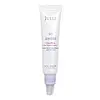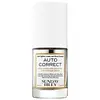What's inside
What's inside
 Key Ingredients
Key Ingredients

 Benefits
Benefits

 Concerns
Concerns

 Ingredients Side-by-side
Ingredients Side-by-side

Water
Skin ConditioningMangifera Indica Seed Butter
Skin ConditioningDimethicone
EmollientGlycerin
HumectantPentylene Glycol
Skin ConditioningIsononyl Isononanoate
EmollientCaprylic/Capric Triglyceride
MaskingCocos Nucifera Fruit Extract
EmollientCaffeine
Skin ConditioningSodium Acrylates Copolymer
Helianthus Annuus Seed Oil
EmollientMusa Sapientum Flower Extract
Skin ConditioningButyrospermum Parkii Butter
Skin ConditioningPhenoxyethanol
PreservativeHydroxyethyl Acrylate/Sodium Acryloyldimethyl Taurate Copolymer
Emulsion StabilisingAmmonium Acryloyldimethyltaurate/Vp Copolymer
Squalane
EmollientSynthetic Fluorphlogopite
Lecithin
EmollientCI 77891
Cosmetic ColorantPolysilicone-11
Sodium Phytate
Steareth-20
CleansingPolysorbate 60
EmulsifyingEthylhexylglycerin
Skin ConditioningSoluble Collagen
HumectantPropanediol
SolventCurcuma Longa Root Extract
MaskingSorbitan Isostearate
EmulsifyingSodium Hyaluronate
HumectantSasa Quelpaertensis Extract
Skin ConditioningPrunus Yedoensis Flower Extract
HumectantTin Oxide
AbrasiveChlorhexidine Digluconate
AntimicrobialN-Hydroxysuccinimide
Skin ConditioningPotassium Sorbate
PreservativeTocopherol
AntioxidantHibiscus Sabdariffa Flower Extract
Skin ConditioningChrysin
Skin ConditioningPalmitoyl Tripeptide-1
Skin ConditioningWater, Mangifera Indica Seed Butter, Dimethicone, Glycerin, Pentylene Glycol, Isononyl Isononanoate, Caprylic/Capric Triglyceride, Cocos Nucifera Fruit Extract, Caffeine, Sodium Acrylates Copolymer, Helianthus Annuus Seed Oil, Musa Sapientum Flower Extract, Butyrospermum Parkii Butter, Phenoxyethanol, Hydroxyethyl Acrylate/Sodium Acryloyldimethyl Taurate Copolymer, Ammonium Acryloyldimethyltaurate/Vp Copolymer, Squalane, Synthetic Fluorphlogopite, Lecithin, CI 77891, Polysilicone-11, Sodium Phytate, Steareth-20, Polysorbate 60, Ethylhexylglycerin, Soluble Collagen, Propanediol, Curcuma Longa Root Extract, Sorbitan Isostearate, Sodium Hyaluronate, Sasa Quelpaertensis Extract, Prunus Yedoensis Flower Extract, Tin Oxide, Chlorhexidine Digluconate, N-Hydroxysuccinimide, Potassium Sorbate, Tocopherol, Hibiscus Sabdariffa Flower Extract, Chrysin, Palmitoyl Tripeptide-1
Water
Skin ConditioningPEG-8 Beeswax
EmulsifyingCaprylyl Caprylate/Caprate
EmollientPolyglyceryl-6 Distearate
EmulsifyingDimethicone
EmollientC10-18 Triglycerides
EmollientGlycerin
HumectantPolypropylsilsesquioxane
Phenyl Trimethicone
Skin ConditioningHydroxyethyl Acrylate/Sodium Acryloyldimethyl Taurate Copolymer
Emulsion StabilisingTrimethylsiloxysilicate
EmollientAnthemis Nobilis Flower Oil
MaskingBoron Nitride
AbsorbentFructose
HumectantJojoba Esters
EmollientSodium Phytate
Theobroma Cacao Seed Butter
EmollientPolyglyceryl-3 Beeswax
EmulsifyingButyrospermum Parkii Butter
Skin ConditioningPropanediol
SolventAesculus Hippocastanum Extract
AntioxidantCoffea Arabica Seed Extract
MaskingMethylpropanediol
SolventAcmella Oleracea Extract
Skin ProtectingPolysilicone-11
Caprylyl Glycol
EmollientCaffeine
Skin ConditioningCitrullus Lanatus Fruit Extract
Skin ConditioningPyrus Malus Fruit Extract
Skin ConditioningLens Esculenta Fruit Extract
Skin ConditioningSodium PCA
HumectantSodium Lactate
BufferingPtychopetalum Olacoides Bark/Stem Extract
Skin ConditioningPfaffia Paniculata Root Extract
SoothingLilium Candidum Flower Extract
Skin ConditioningPhenoxyethanol
PreservativeGlycolic Acid
BufferingSynthetic Fluorphlogopite
Silica
AbrasiveMica
Cosmetic ColorantTitanium Dioxide
Cosmetic ColorantCarthamus Tinctorius Seed Oil
MaskingTagetes Erecta Flower Extract
PerfumingTriethyl Citrate
MaskingCetyl Alcohol
EmollientCaprylyl/Capryl Glucoside
CleansingBenzoic Acid
MaskingLecithin
EmollientPolysorbate 60
EmulsifyingSorbitan Isostearate
EmulsifyingPotassium Sorbate
PreservativeBenzyl Alcohol
PerfumingSodium Benzoate
MaskingCitric Acid
BufferingLinalool
PerfumingLimonene
PerfumingWater, PEG-8 Beeswax, Caprylyl Caprylate/Caprate, Polyglyceryl-6 Distearate, Dimethicone, C10-18 Triglycerides, Glycerin, Polypropylsilsesquioxane, Phenyl Trimethicone, Hydroxyethyl Acrylate/Sodium Acryloyldimethyl Taurate Copolymer, Trimethylsiloxysilicate, Anthemis Nobilis Flower Oil, Boron Nitride, Fructose, Jojoba Esters, Sodium Phytate, Theobroma Cacao Seed Butter, Polyglyceryl-3 Beeswax, Butyrospermum Parkii Butter, Propanediol, Aesculus Hippocastanum Extract, Coffea Arabica Seed Extract, Methylpropanediol, Acmella Oleracea Extract, Polysilicone-11, Caprylyl Glycol, Caffeine, Citrullus Lanatus Fruit Extract, Pyrus Malus Fruit Extract, Lens Esculenta Fruit Extract, Sodium PCA, Sodium Lactate, Ptychopetalum Olacoides Bark/Stem Extract, Pfaffia Paniculata Root Extract, Lilium Candidum Flower Extract, Phenoxyethanol, Glycolic Acid, Synthetic Fluorphlogopite, Silica, Mica, Titanium Dioxide, Carthamus Tinctorius Seed Oil, Tagetes Erecta Flower Extract, Triethyl Citrate, Cetyl Alcohol, Caprylyl/Capryl Glucoside, Benzoic Acid, Lecithin, Polysorbate 60, Sorbitan Isostearate, Potassium Sorbate, Benzyl Alcohol, Sodium Benzoate, Citric Acid, Linalool, Limonene
 Reviews
Reviews

Alternatives
Ingredients Explained
These ingredients are found in both products.
Ingredients higher up in an ingredient list are typically present in a larger amount.
This ingredient is also known as shea butter. It is an effective skin hydrator and emollient.
Emollients help soothe and soften your skin. It does this by creating a protective film on your skin. This barrier helps trap moisture and keeps your skin hydrated. Emollients may be effective at treating dry or itchy skin.
Shea butter is rich in antioxidants. Antioxidants help fight free-radicals, or molecules that may harm the body. It is also full of fatty acids including stearic acid and linoleic acid. These acids help replenish the skin and keep skin moisturized.
While Shea Butter has an SPF rating of about 3-4, it is not a sunscreen replacement.
Shea butter may not be fungal acne safe. We recommend speaking with a professional if you have any concerns.
Learn more about Butyrospermum Parkii ButterCaffeine is most associated with coffee, tea, and cacao. In skincare, it helps with calming inflammation and is rich in antioxidants.
While caffeine is used to treat cellulite and and dark circles, further studies are needed to prove this. It has been believed to help with these skin conditions due to its ability to dilate blood vessels and increase blood flow.
Some studies are looking into caffeine's ability to protect against UV rays.
Learn more about CaffeineDimethicone is a type of synthetic silicone created from natural materials such as quartz.
What it does:
Dimethicone comes in different viscosities:
Depending on the viscosity, dimethicone has different properties.
Ingredients lists don't always show which type is used, so we recommend reaching out to the brand if you have questions about the viscosity.
This ingredient is unlikely to cause irritation because it does not get absorbed into skin. However, people with silicone allergies should be careful about using this ingredient.
Note: Dimethicone may contribute to pilling. This is because it is not oil or water soluble, so pilling may occur when layered with products. When mixed with heavy oils in a formula, the outcome is also quite greasy.
Learn more about DimethiconeGlycerin is already naturally found in your skin. It helps moisturize and protect your skin.
A study from 2016 found glycerin to be more effective as a humectant than AHAs and hyaluronic acid.
As a humectant, it helps the skin stay hydrated by pulling moisture to your skin. The low molecular weight of glycerin allows it to pull moisture into the deeper layers of your skin.
Hydrated skin improves your skin barrier; Your skin barrier helps protect against irritants and bacteria.
Glycerin has also been found to have antimicrobial and antiviral properties. Due to these properties, glycerin is often used in wound and burn treatments.
In cosmetics, glycerin is usually derived from plants such as soybean or palm. However, it can also be sourced from animals, such as tallow or animal fat.
This ingredient is organic, colorless, odorless, and non-toxic.
Glycerin is the name for this ingredient in American English. British English uses Glycerol/Glycerine.
Learn more about GlycerinThis is a synthetic polymer. It helps improve the texture of products by adding thickness and gel-like feel.
It is also an emulsifer, meaning it prevents ingredients such as oil and water from separating. It also helps evenly disperse other ingredients.
Lecithin is a term for a group of substances found in the cell membranes of plants, animals, and humans. They are made up of mixture of phospholipids.
This ingredient has emollient and emulsifying properties.
As an emollient, lecithen helps soften the skin and creates a barrier to keep moisture in.
As an emulsifier, it also helps prevent water and oil ingredients from separating. Lecithin can also help ingredients be better absorbed by the skin.
This is because the phospholipids in lecithin produce liposomes. Liposomes help other ingredients get through the skin barrier.
Depending on the source of this ingredient, lecithin may not be fungal acne safe. This is because some sources of lecithin come from soybean oil, which may feed the malassezia yeast that feeds fungal acne.
We recommend reaching out to the brand you are purchasing from to inquire about the source of their lecithin.
Some other names for this ingredient include soy lecithin and deoiled soy lecithin.
Learn more about LecithinPhenoxyethanol is a preservative that has germicide, antimicrobial, and aromatic properties. Studies show that phenoxyethanol can prevent microbial growth. By itself, it has a scent that is similar to that of a rose.
It's often used in formulations along with Caprylyl Glycol to preserve the shelf life of products.
Polysilicone-11 is a film-forming silicone that creates a non-tacky and matte finish on the skin. It's commonly used to improve texture, absorb excess oil, and help active ingredients spread evenly.
Due to its "rubber-like" structure, it stays on the skin's surface instead of being absorbed. On the skin, it creates a flexible layer that enhances wearability and stability.
Polysorbate 60 is used to help stabilize products. It is a surfactant and emulsifier. These properties help keep ingredients together in a product. Surfactants help reduce surface tension between ingredients with different states, such as liquids and solids. Emulsifiers help prevent oils and waters from separating.
Polysorbate 60 is sorbitol-based and created from the ethoxylation of sorbitan. Ethoxylation is a chemical reaction used to add ethylene oxide. Sorbitan is a the dehydrated version of sorbitol, a sugar found in fruits.
In this case, the 60 comes from reacting 60 units of ethylene oxide with sorbitan.
Polysorbates are commonly used in medicine and foods.
Learn more about Polysorbate 60Potassium Sorbate is a preservative used to prevent yeast and mold in products. It is commonly found in both cosmetic and food products.
This ingredient comes from potassium salt derived from sorbic acid. Sorbic acid is a natural antibiotic and effective against fungus.
Both potassium sorbate and sorbic acid can be found in baked goods, cheeses, dried meats, dried fruit, ice cream, pickles, wine, yogurt, and more.
You'll often find this ingredient used with other preservatives.
Learn more about Potassium SorbatePropanediol is an all-star ingredient. It softens, hydrates, and smooths the skin.
It’s often used to:
Propanediol is not likely to cause sensitivity and considered safe to use. It is derived from corn or petroleum with a clear color and no scent.
Learn more about PropanediolSodium Phytate is the synthetic salt form of phytic acid. Phytic acid is an antioxidant and can be found in plant seeds.
Sodium Phytate is a chelating agent. Chelating agents help prevent metals from binding to water. This helps stabilize the ingredients and the product.
Sorbitan Isostearate is an emulsifer and cleaning agent. It is created from isostearic acid and sorbitol.
As an emulsifier, Sorbitan Isostearate prevents oils and water from separating.
Due to its isostearic acid base, it may not be safe for Malassezia or fungal acne.
Learn more about Sorbitan IsostearateSynthetic Fluorphlogopite is the synthethic version of mica. It consists of fluorine, aluminum and silicate.
Synthetic Fluorphlogopite is used to add volume to products.
It is considered non-irritating on the skin.
Learn more about Synthetic FluorphlogopiteWater. It's the most common cosmetic ingredient of all. You'll usually see it at the top of ingredient lists, meaning that it makes up the largest part of the product.
So why is it so popular? Water most often acts as a solvent - this means that it helps dissolve other ingredients into the formulation.
You'll also recognize water as that liquid we all need to stay alive. If you see this, drink a glass of water. Stay hydrated!
Learn more about Water